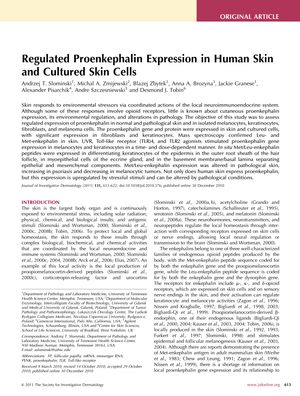Regulated Proenkephalin Expression in Human Skin and Cultured Skin Cells
December 2010
in “
The journal of investigative dermatology/Journal of investigative dermatology
”

TLDR Human skin cells produce proenkephalin, which changes with environmental factors and skin diseases.
The study from 2011 investigated the expression of proenkephalin, a precursor to opioid peptides, in human skin and skin cells, including melanocytes, keratinocytes, fibroblasts, and melanoma cells. It found that proenkephalin is indeed expressed in these cells, with notable expression in fibroblasts and keratinocytes. Mass spectroscopy confirmed the presence of Leu- and Met-enkephalin peptides in the skin. The study also demonstrated that ultraviolet radiation (UVR) and agonists for Toll-like receptors 4 and 2 can stimulate the expression of the proenkephalin gene in a time- and dose-dependent manner. Furthermore, the expression of Met/Leu-enkephalin peptides was found in various skin components and was shown to increase in psoriasis and decrease in melanocytic tumors, indicating that proenkephalin expression is subject to change in pathological conditions. This research suggests that the skin's response to stress involves proenkephalin and that its expression can be regulated by environmental factors and altered in skin diseases. The number of participants or samples used in the study was not provided.



